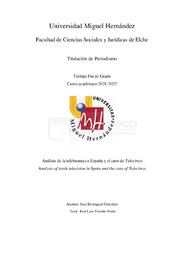Por favor, use este identificador para citar o enlazar este ítem:
https://hdl.handle.net/11000/27790Registro completo de metadatos
| Campo DC | Valor | Lengua/Idioma |
|---|---|---|
| dc.contributor.advisor | Vicente Ferris, José Luis | - |
| dc.contributor.author | Berenguer González, Sara | - |
| dc.contributor.other | Departamentos de la UMH::Ciencias Sociales y Humanas | es_ES |
| dc.date.accessioned | 2022-10-06T11:06:49Z | - |
| dc.date.available | 2022-10-06T11:06:49Z | - |
| dc.date.created | 2022-06-06 | - |
| dc.identifier.uri | https://hdl.handle.net/11000/27790 | - |
| dc.description.abstract | Los programas telebasura siempre han sido criticados por la opinión pública. Sin embargo, son los más consumidos por la audiencia. Por ello, este trabajo presenta un estudio detallado de como esta forma de hacer televisión se ha implantado en el sistema televisivo español. Observa la evolución de la televisión desde el nacimiento de TVE en 1956, hasta hallar los primeros indicios de telebasura en las parrillas españolas. Posteriormente, se indaga en los programas que originaron y ayudaron a definir este género como Tómbola, Crónicas Marcianas y Gran Hermano. Por otra parte, el análisis se centra en el estudio de caso de Telecinco- de la corporación Mediaset, cadena que destaca por haber logrado el éxito ofreciendo este tipo de contenidos de baja calidad. Finalmente, concluye con un análisis práctico, donde analiza y mide los índices de telebasura de los programas más exitosos de la cadena: Supervivientes, Sálvame Diario y Sábado Deluxe, y La isla de las tentaciones. Con el fin de conocer cómo es el entretenimiento que consume la sociedad española actual. | es_ES |
| dc.description.abstract | Trash TV programs have always been criticized by public opinion. However, they are the most consumed by the audience. For this reason, this work presents a detailed study of how this way of making television has been implemented in the Spanish television system. Observe the evolution of television from the birth of TVE in 1956, until find the first signs of trash TV on Spanish TV programme grids. Subsequently investigate about the programs that originated and helped define this genre such as Tómbola, Crónicas Marcianas and Big Brother. On the other hand, the analysis focuses on the case study of Telecinco – witch belongs on the mass media company Mediaset, this TV channel stands out for having achieved success by offering this type of low-quality content. Finally, conclude with a practical analysis, where it is analyzed and measured the trash TV rates of the channel´s most successful programs: Survivors, Sálvame Diario and Sábado Deluxe, and The Island of Temptations. In this way to know how is the entertainment consumed by the current Spanish society. | es_ES |
| dc.format | application/pdf | es_ES |
| dc.format.extent | 95 | es_ES |
| dc.language.iso | spa | es_ES |
| dc.publisher | Universidad Miguel Hernández de Elche | es_ES |
| dc.rights | info:eu-repo/semantics/openAccess | es_ES |
| dc.rights | Attribution-NonCommercial-NoDerivatives 4.0 Internacional | * |
| dc.rights.uri | http://creativecommons.org/licenses/by-nc-nd/4.0/ | * |
| dc.subject | telebasura | es_ES |
| dc.subject | Telecinco | es_ES |
| dc.subject | televisión | es_ES |
| dc.subject | evolución | es_ES |
| dc.subject | entretenimiento | es_ES |
| dc.subject | trash TV | es_ES |
| dc.subject | television | es_ES |
| dc.subject | evolution | es_ES |
| dc.subject | entertainment | es_ES |
| dc.subject.other | CDU::0 - Generalidades.::070 - Periódicos. Prensa. Periodismo. Ciencias de la información | es_ES |
| dc.title | Análisis de la telebasura en España y el caso de Telecinco | es_ES |
| dc.title.alternative | Analysis of trash television in Spain and the case of Telecinco | es_ES |
| dc.type | info:eu-repo/semantics/bachelorThesis | es_ES |

Ver/Abrir:
TFG-Berenguer González, Sara.pdf
3,32 MB
Adobe PDF
Compartir:
 La licencia se describe como: Atribución-NonComercial-NoDerivada 4.0 Internacional.
La licencia se describe como: Atribución-NonComercial-NoDerivada 4.0 Internacional.
.png)